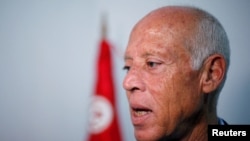The 2023-2025 plan "puts forward a new model of development" to reset Tunisia's economy and battle poverty, which currently affects around a fifth of the 12 million population, Economy Minister Samir Saied said.
Tunisian authorities are hoping to secure a nearly $2-billion bailout from the International Monetary Fund they hope will unlock other sources of international financing.
Saied said the plan unveiled Tuesday, which is based on growth of 2.1 percent this year -- compared to 1.8 percent last year -- was "realistic and prudent".
He predicted a fall in unemployment of just one percentage point to 14 percent between 2022 and 2025.
Saied said private sector investment should be the "engine of growth", calling for improvements to Tunisia's notoriously closed business climate.
He laid out plans for $12.3 billion dollars in public investments over the three years, two-thirds via the state budget and the remainder through publicly owned companies.
Industry Minister Neila Gonji, who presented part of the plan, said increased investment in industry could see the sector grow from 15 to 18 percent of Gross Domestic Product by 2025, with exports growing by a third to $18 billion a year.
The plan also seeks to boost production of phosphates, one of Tunisia's rare natural resources, from 3.7 million tons last year to 12 million tons in 2025.
The highly polluting industry, which has decimated ocean life off the city of Gabes, has been largely stalled over the past decade due to social unrest and high-level corruption, but a shortage on global markets due to the war in Ukraine could present an opportunity for Tunisian exports.
The government also plans to allow farming land to be used for solar and wind energy generation, as well as allowing small-scale solar projects in a market that is currently dominated by state-owned firm STEG.
The plan lays out a program of improvements to the social security system, with payouts for families looking after elderly non-relatives, and investments in education for school dropouts.
Tunis Unveils New Development Plan

TUNIS —



